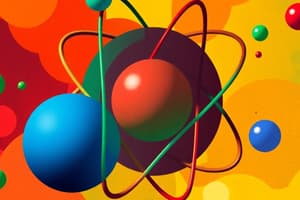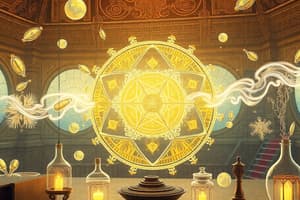Podcast
Questions and Answers
What is the fundamental building block of all matter in the universe?
What is the fundamental building block of all matter in the universe?
- Molecules
- Atoms (correct)
- Compounds
- Elements
Which subatomic particle was discovered through the cathode ray experiments of J.J. Thompson in 1897?
Which subatomic particle was discovered through the cathode ray experiments of J.J. Thompson in 1897?
- Neutron
- Electron (correct)
- Quark
- Proton
What did Ernest Rutherford's alpha scattering experiment in 1911 reveal about the structure of the atom?
What did Ernest Rutherford's alpha scattering experiment in 1911 reveal about the structure of the atom?
- The existence of the nucleus (correct)
- The presence of energy levels
- The existence of the electron cloud
- The existence of orbitals
According to Niels Bohr's atomic model, how do electrons move between energy levels?
According to Niels Bohr's atomic model, how do electrons move between energy levels?
In the modern quantum mechanical model of the atom, how are electrons described?
In the modern quantum mechanical model of the atom, how are electrons described?
If an atom loses two electrons, what is the net charge of the resulting ion?
If an atom loses two electrons, what is the net charge of the resulting ion?
What is the fundamental unit of an element that can exist alone or in combination with other elements?
What is the fundamental unit of an element that can exist alone or in combination with other elements?
According to Dalton's atomic theory, how do atoms combine to produce compounds?
According to Dalton's atomic theory, how do atoms combine to produce compounds?
What is the fundamental unit of energy in the universe?
What is the fundamental unit of energy in the universe?
What is the net charge of a neutral atom?
What is the net charge of a neutral atom?
Flashcards are hidden until you start studying
Study Notes
- The entire universe is made up of matter and energy, with all matter being composed of elements that cannot be broken down by chemical activity.
- Atoms are the building blocks of everything in the universe, being the smallest unit of an element that can exist alone or in combination with atoms of the same or different elements.
- Dalton's atomic theory proposed in 1803 states that matter is made up of small, invisible, indivisible particles called atoms, which combine in whole number ratios to produce compounds.
- The discovery of the electron in 1897 through cathode ray experiments by J.J. Thompson led to the understanding that atoms are composed of subatomic particles with electrical charges.
- Ernest Rutherford's alpha scattering experiment in 1911 led to the discovery of the nucleus of the atom, distinguishing between the positively charged nucleus and the negatively charged electrons revolving around it.
- Niels Bohr proposed an atomic model where electrons revolve around the nucleus in specific energy levels, with the ability to move between levels by absorbing or releasing energy.
- The modern quantum mechanical model of the atom suggests that electrons are found in specific energy levels, not stationary, and occupy specific atomic orbitals within the electron cloud surrounding the nucleus.- To find the net charge of an ion, subtract the number of protons from the number of electrons.
- A magnesium ion lost two electrons, resulting in a net positive charge of 2.
- A positive ion is called a cation when an atom loses an electron, leading to an imbalance in protons and electrons.
- Isotopes are atoms of the same element with different mass numbers, having the same number of protons but varying numbers of neutrons.
- Most elements have multiple isotopes; for example, hydrogen has three isotopes: protium, deuterium, and tritium, with different atomic masses.
Studying That Suits You
Use AI to generate personalized quizzes and flashcards to suit your learning preferences.




